Numerical Simulation-Based Study on Influence of Different Connection Configurations of Viscous Dampers on Seismic Performance
Abstract
1. Introduction
2. Research Methodology
3. Working Mechanism of Viscous Damper Connection Configurations
4. Seismic Mitigation Mechanism of Viscous Dampers
5. Engineering Case Study
5.1. Project Overview
5.2. Model Development
5.3. Selection of Seismic Waves
5.4. Elastic Time–History Analysis
6. Results Analysis
6.1. Maximum Inter-Story Drift
6.2. Energy Dissipation Characteristics of Viscous Dampers
7. Discussion
8. Conclusions
- (1)
- Under identical seismic mitigation conditions, for frame structures similar to the hospital structure, both the herringbone and wall-mounted connections exhibit superior seismic reduction performance compared to the diagonal bracings. This is evidenced by the fact that under different seismic loads, the maximum inter-story drifts of structures employing herringbone and wall-mounted connections are consistently smaller than those using diagonal bracing connections.
- (2)
- In terms of the applicability of connection types, the chevron bracings are suitable for medium-to-high-rise frame structures similar to the hospital structure, where its seismic reduction effect is more pronounced. While the wall-mounted connections demonstrate slightly better seismic performance than the chevron connection in low-rise frame structures of a similar type, their effectiveness is diminished in medium- to high-rise frame structures due to the influence of wall self-weight, resulting in less optimal seismic reduction compared to chevron bracings.
- (3)
- Energy Dissipation Mechanism: Viscous dampers effectively dissipate seismic energy, as evidenced by their velocity-dependent hysteretic curves. The hysteretic curves confirm robust energy absorption, validating their role in seismic mitigation.
Author Contributions
Funding
Data Availability Statement
Conflicts of Interest
References
- GB 50223-1995; Classification standard for seismic fortification of buildings. Ministry of Construction of the People’s Republic of China: Beijing, China, 1995.
- GB 50223-2008; Classification Standard for Seismic Fortification of Building Engineering. SBTS: Louisville, KY, USA, 2008.
- GB 50223-2004; Standard for Classification of Seismic Fortification of Building Engineering (with article description). SBTS: Louisville, KY, USA, 2004.
- Constantinou, M.C.; Tsopelas, P.; Hammel, W.; Sigaher, A.N. Toggle-Brace-Damper Seismic Energy Dissipation Systems. J. Struct. Eng. 2001, 127, 105–112. [Google Scholar] [CrossRef]
- Alhamdany, A.M.A.; Dilsiz, A. Comparative evaluation of shear walls and fluid viscous dampers in seismic retrofitting of RC public school buildings. Structures 2025, 72, 108231. [Google Scholar] [CrossRef]
- Sebaq, M.S.; Xiao, Y.; Song, G. Damage indices of steel moment-resisting frames equipped with fluid viscous dampers. J. Asian Archit. Build. Eng. 2023, 22, 3496–3515. [Google Scholar] [CrossRef]
- Yi, L.; Haiwen, T.; Da, H. Research on seismic performance of viscous dampers with different connection modes. Eng. Seism. Resist. Reinf. 2008, 6, 60. [Google Scholar]
- Chengzhi, W.; Zhen, H.; Kangan, L. Energy dissipation and vibration reduction design using viscous dampers in a certain hospital. Archit. Struct. 2012, 201, 473–477. [Google Scholar]
- Chenglong, H. Study on the Similarity Relationship of Shaking Table Test of Steel Frame Model with Additional Viscous Damper; Xi’an University of Architecture and Technology: Xi’an, China, 2022. [Google Scholar]
- Xiao, X. Study on the Influence of Viscous Damper on Seismic Performance of Reinforced Concrete Frame Structure; Shandong Jianzhu University: Jinan, China, 2023. [Google Scholar]
- Zhu, L. Research on the Application of Viscous Damper in Energy Dissipation and Shock Absorption in Frame Structure; Xiamen University: Xiamen, China, 2020. [Google Scholar]
- Yang, X. Seismic Optimization Design of Low-Rise Buildings Based on Viscous Dampers; Dalian University of Technology: Dalian, China, 2015. [Google Scholar]
- Song, L. Research on Shock Absorption of Cable-Stayed Bridges Based on Viscous Dampers; Beijing Jiaotong University: Beijing, China, 2012. [Google Scholar]
- Wang, R. Design and Analysis of Shock Absorption Performance of Multi-Story Steel Structure Factory Buildings; North China University of Water Resources and Electric Power: Zhengzhou, China, 2023. [Google Scholar]
- Lu, M. Application of Boom Truss-Damper System in Wind Resistance and Vibration Reduction of Super High-Rise Buildings; Yanshan University: Qinhuangdao, China, 2023. [Google Scholar]
- Jia, B.; Luo, X.; Ding, J.; Zhang, Q. Research on seismic reduction effect of viscous dampers on space truss structures. Vib. Shock. 2014, 33, 124–130. [Google Scholar]
- Gattulli, V. Passive Energy Dissipation Systems in Structural Engineering T.T. Soong and G.F. Dargush John Wiley & Sons, Chichester. Meccanica 1999, 34, 65–66. [Google Scholar]
- Tiwari, P.; Badal, P.; Suwal, R. Effectiveness of fluid viscous dampers in the seismic performance enhancement of RC buildings. Asian J. Civ. Eng. 2023, 24, 309–318. [Google Scholar] [CrossRef]
- Gu, J.; Ma, Z.-D.; Hulbert, G.M. A new load-dependent Ritz vector method for structural dynamics analyses: Quasi-static Ritz vectors. Finite Elem. Anal. Des. 2000, 36, 261–278. [Google Scholar] [CrossRef]
- Ras, A. Far-field earthquake response examination of RC buildings equipped with fluid viscous dampers. Asian J. Civ. Eng. 2025, 26, 357–371. [Google Scholar] [CrossRef]
- Pu, Y.; Yingmin, L.; Ming, L. Selection control index of input seismic wave in structural time history analysis method. J. Civ. Eng. 2000, 33, 33–37. [Google Scholar]
- Zhe, Q.; Lieping, Y.; Peng, P. Comparative study on selection methods of ground motion records in elastoplastic time history analysis of building structures. J. Civ. Eng. 2011, 44, 10–21. [Google Scholar]
- GB 50011-2001; Code for Seismic Design of Buildings. SBTS: Louisville, KY, USA, 2001.
- Gong, Y.; Zhou, H.; Chen, P.; Yuan, M. Comparison of fast subspace iteration method, iterative Ritz vector method and iterative Lanczos method. J. Vib. Eng. 2005, 18, 227–232. [Google Scholar]
- Li, X.; Li, X. Peak adjustment method of input seismic wave in time history analysis of long-span cable-stayed bridge. Adv. Earthq. Sci. 2023, 53, 11–20. [Google Scholar]
- Patil, R.A.; Salgar, P.B. An investigation for enhancing seismic performance of high-rise buildings using fluid viscous damper (FVD). Asian J. Civ. Eng. 2024, 25, 4803–4817. [Google Scholar] [CrossRef]
- Shi, M.; Wang, P.; Xu, X.; Choi, Y. Nonlinear Time History Analysis for the Different Column Orientations under Seismic Wave Synthetic Approach. World J. Eng. Technol. 2024, 3, 587–616. [Google Scholar] [CrossRef]
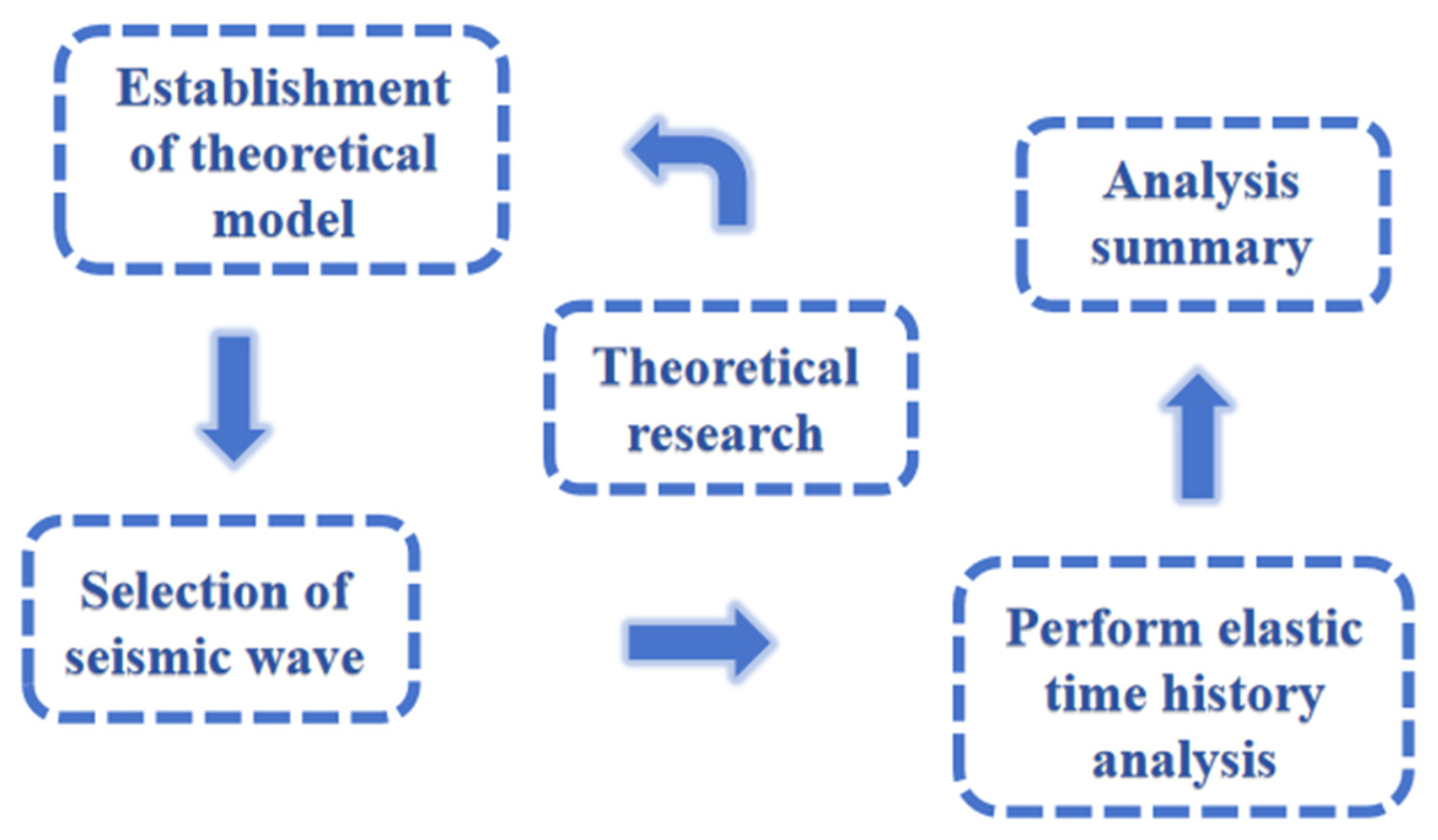
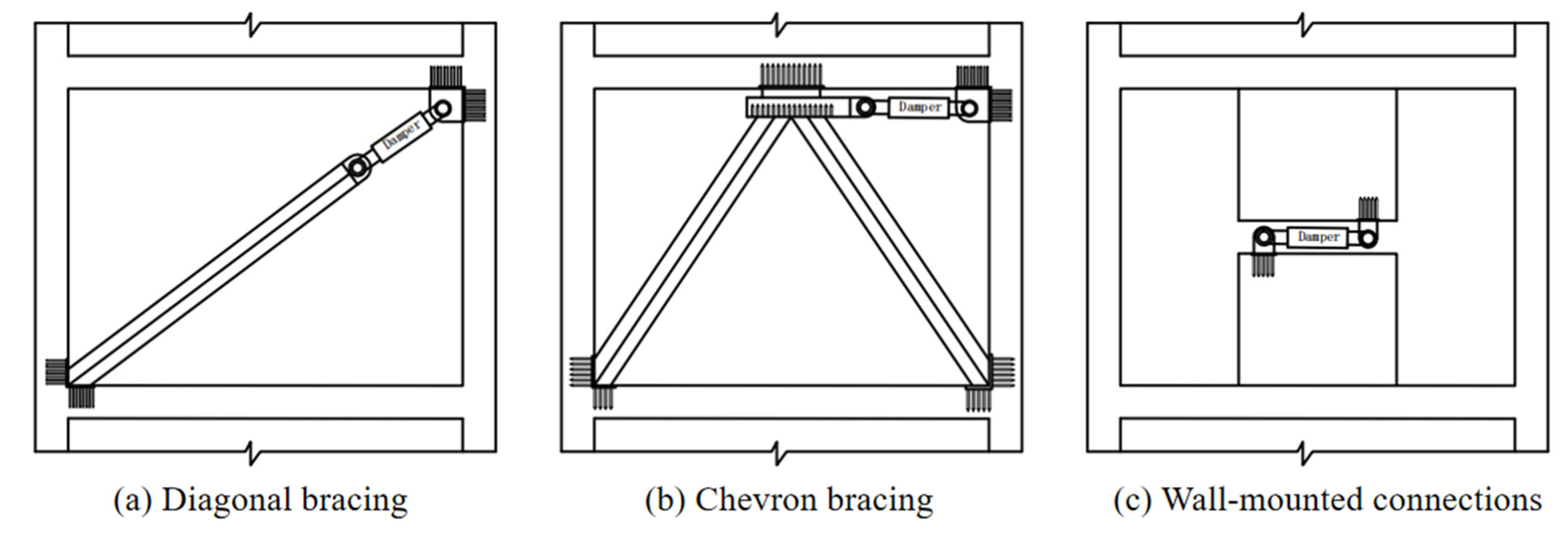
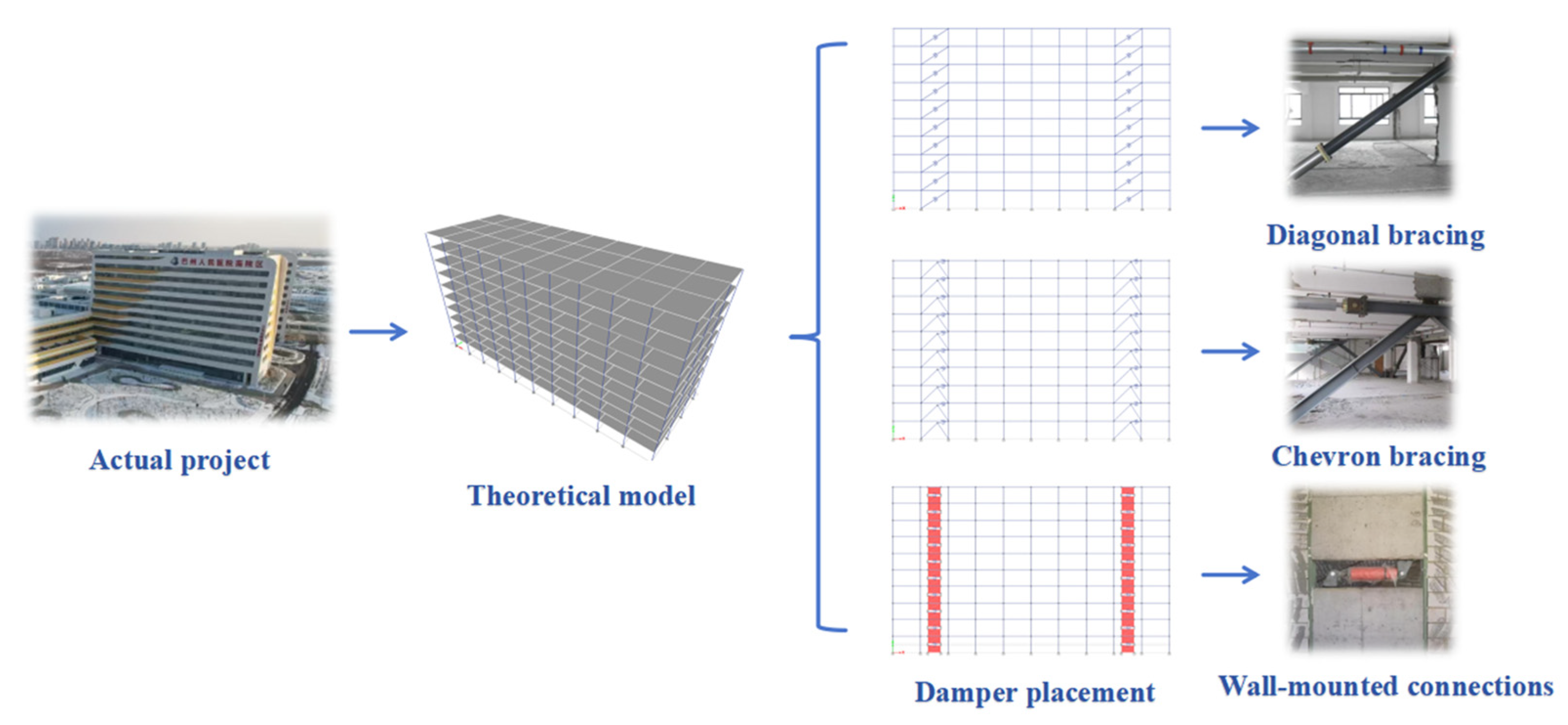

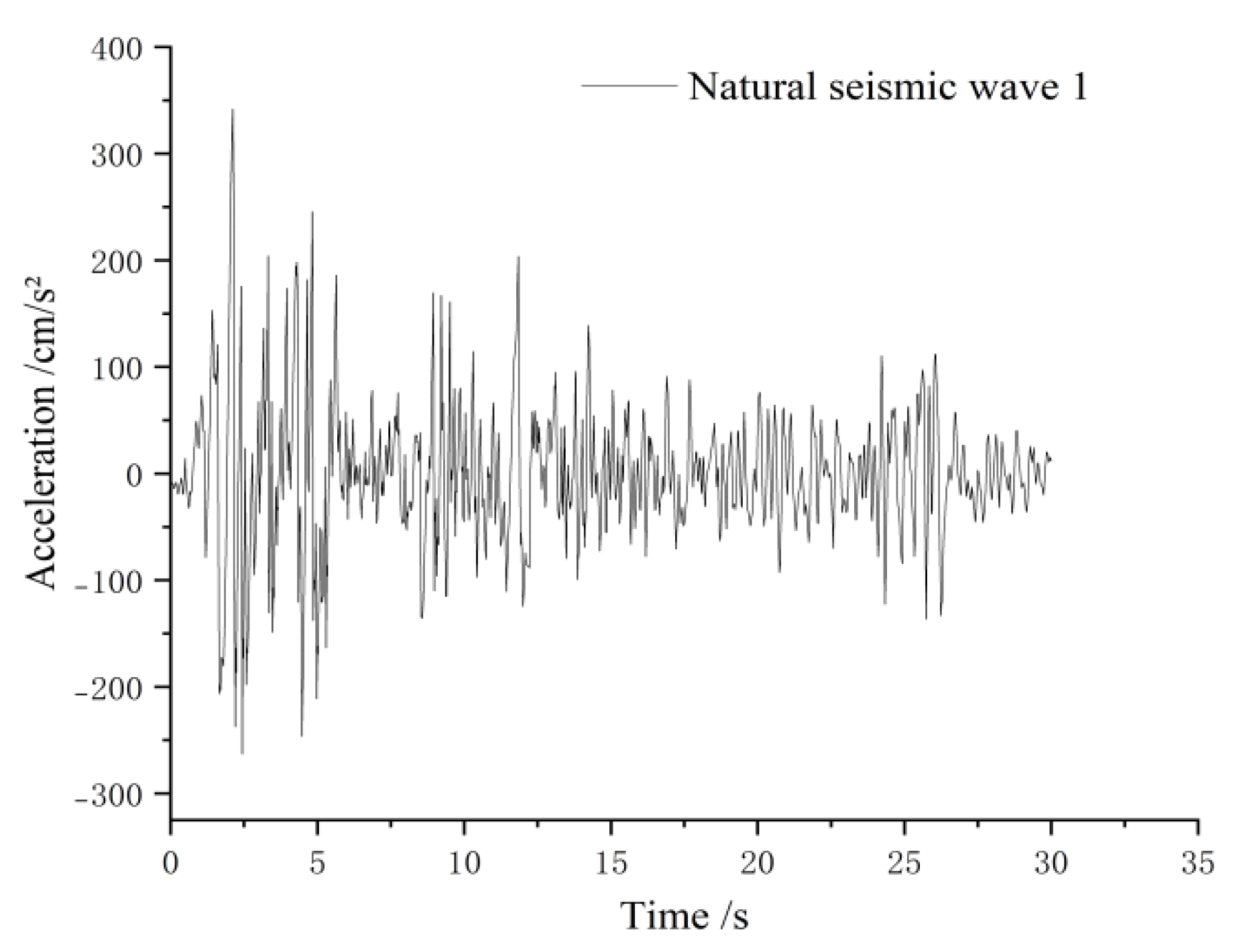
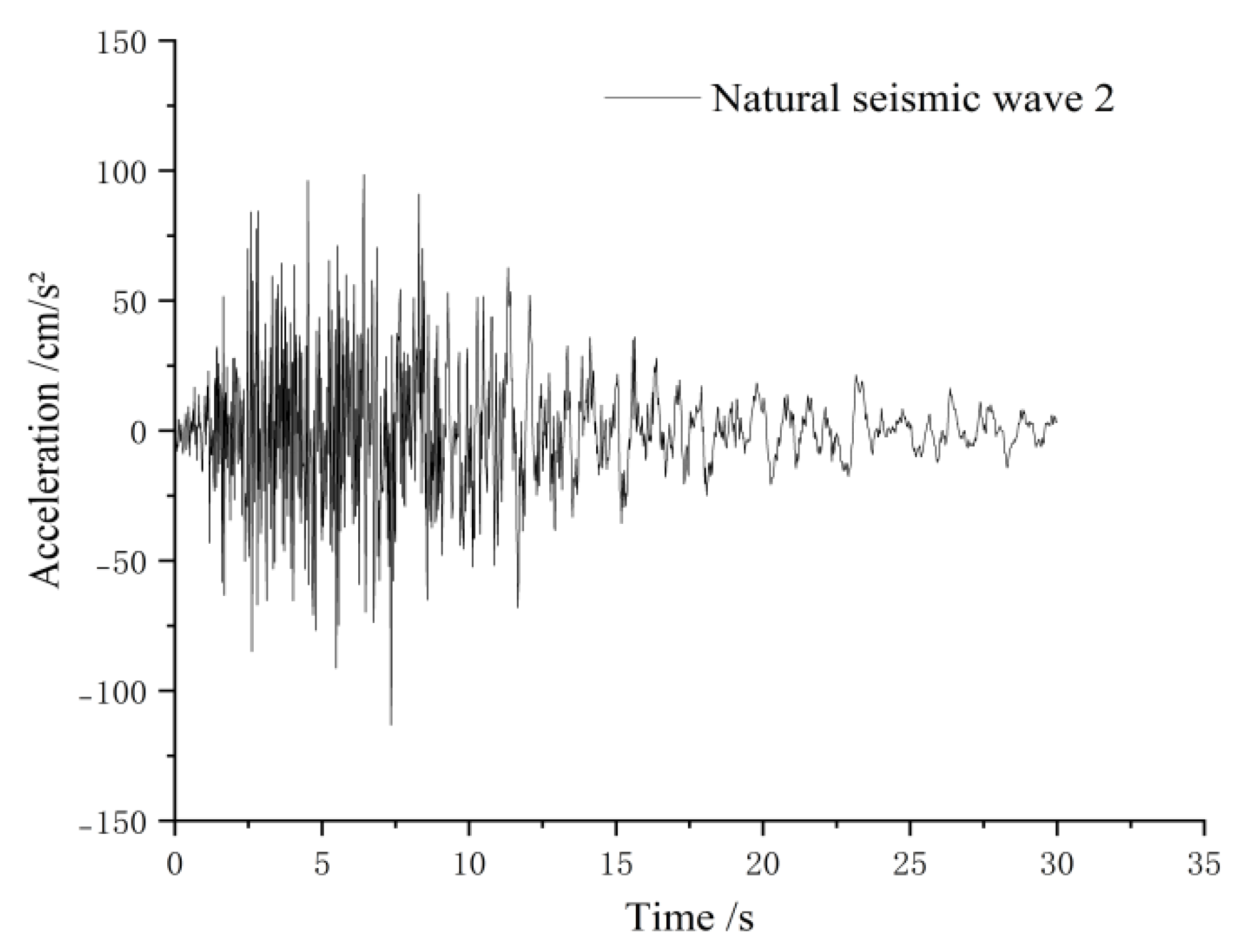
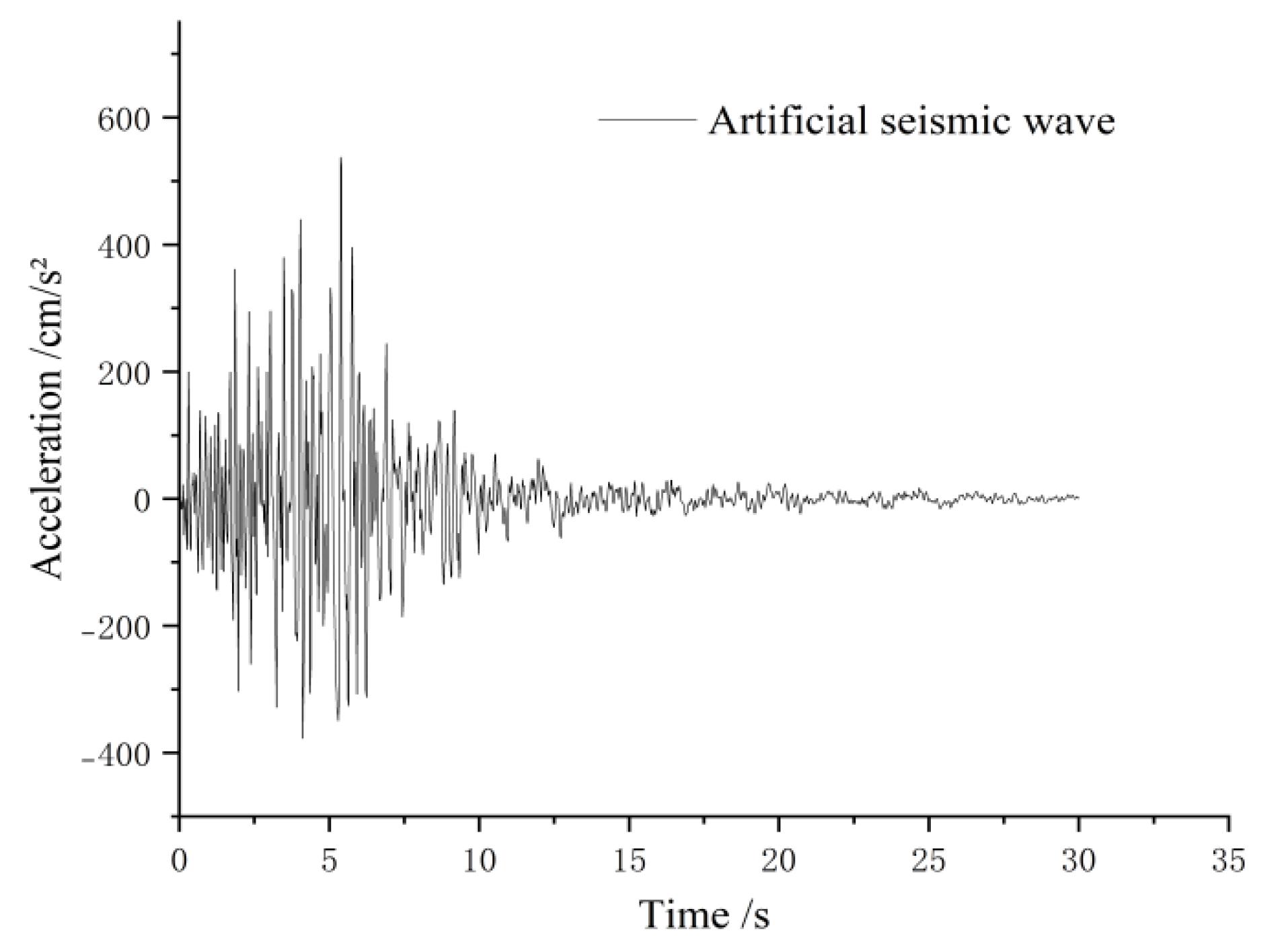

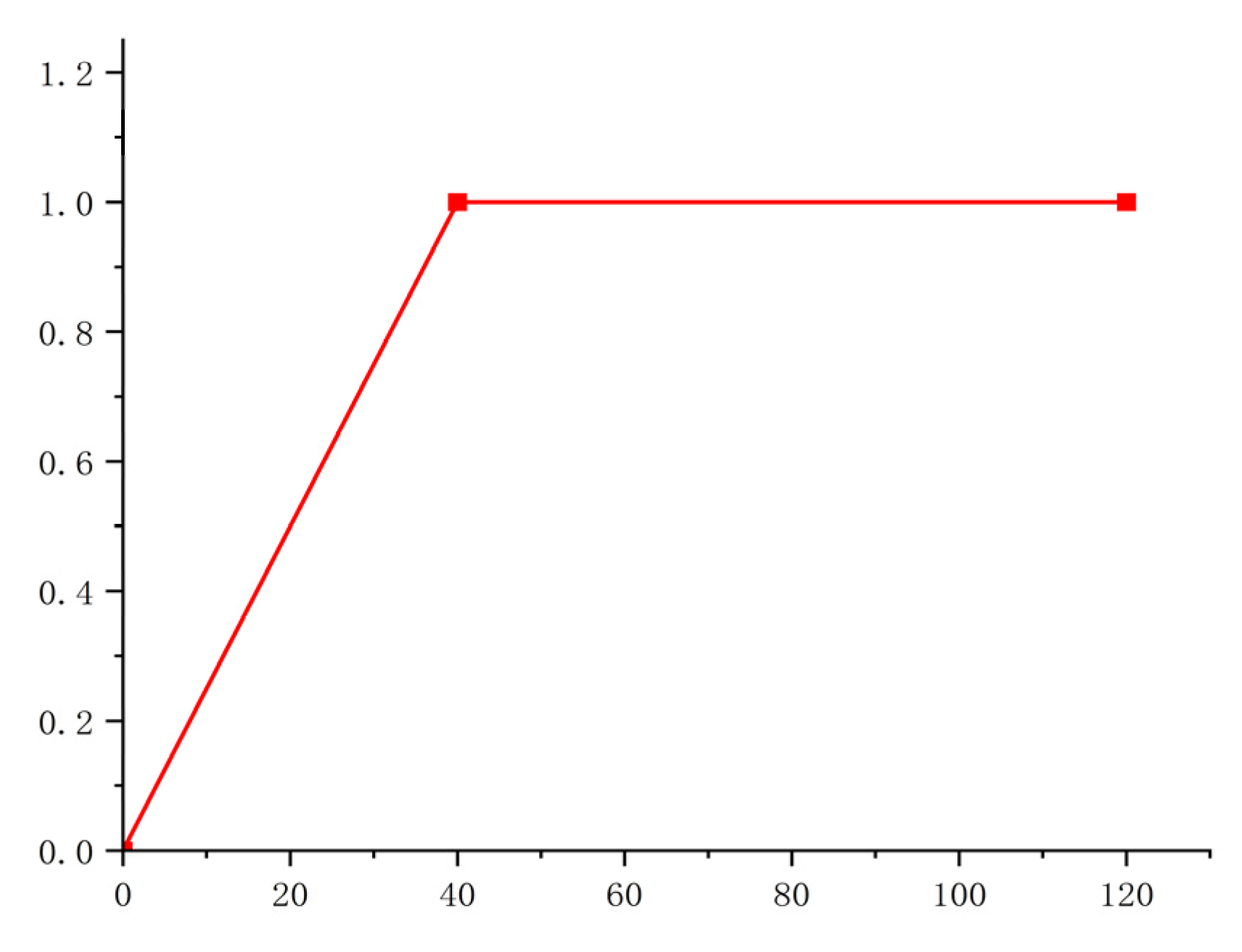
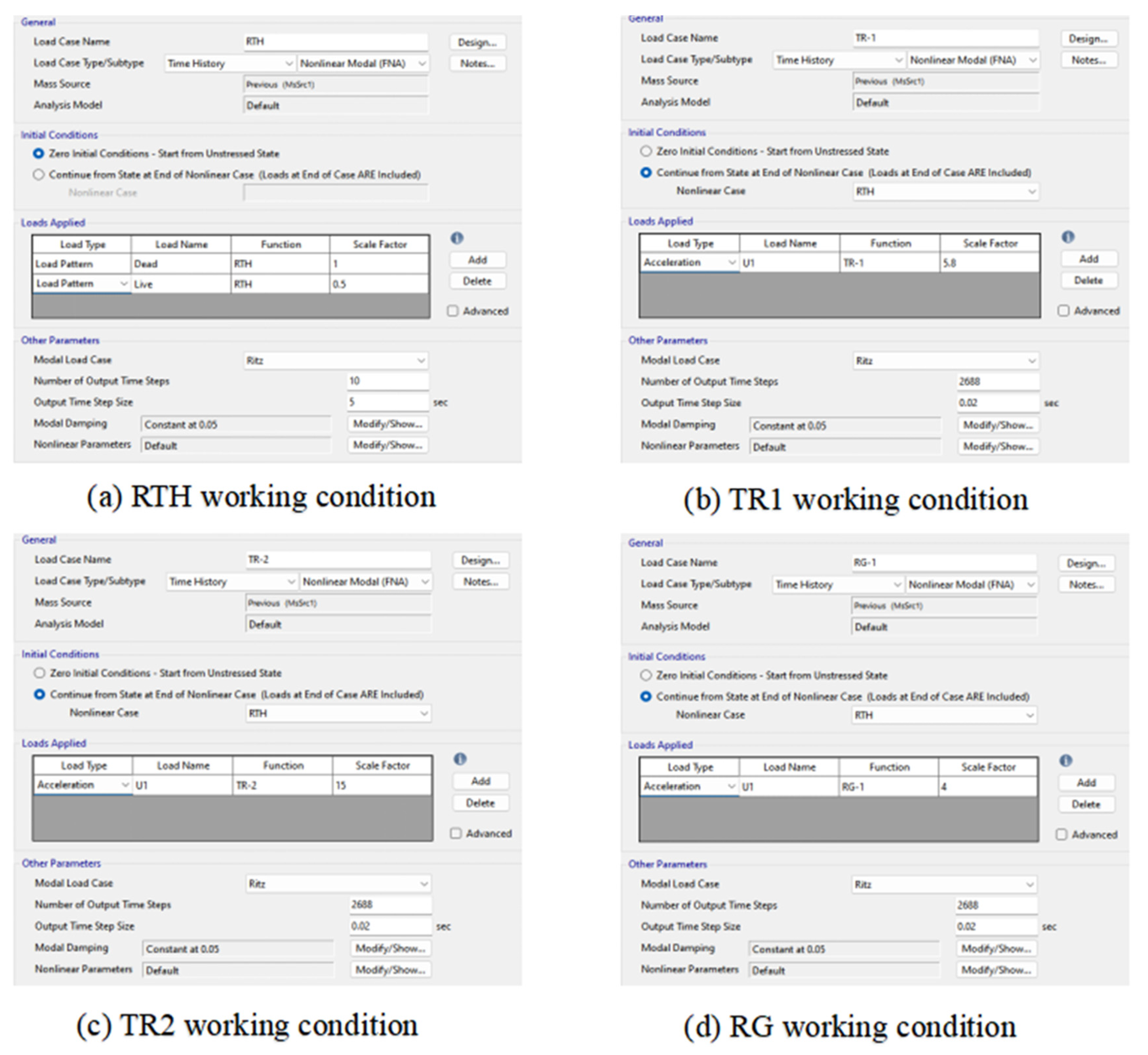
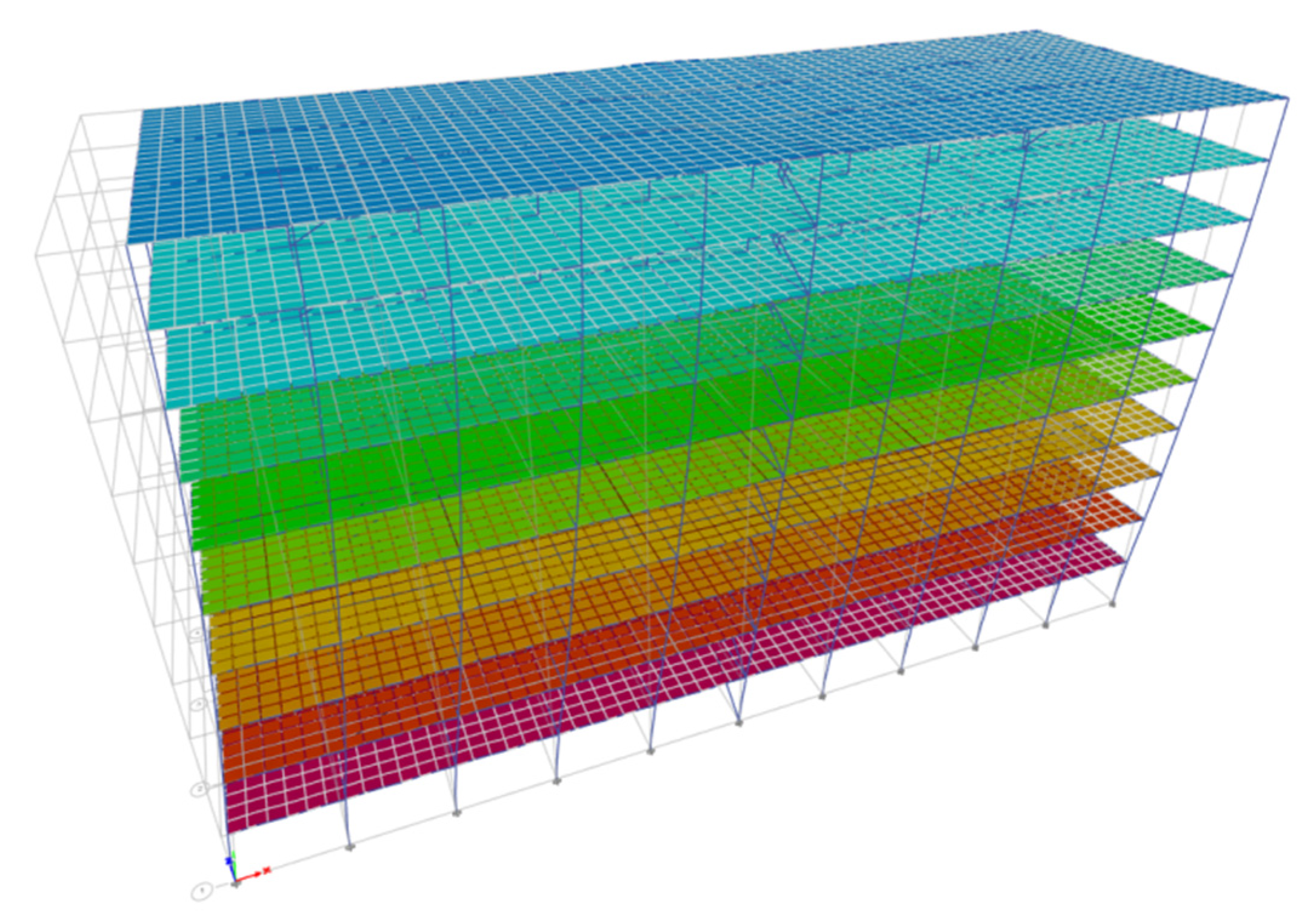
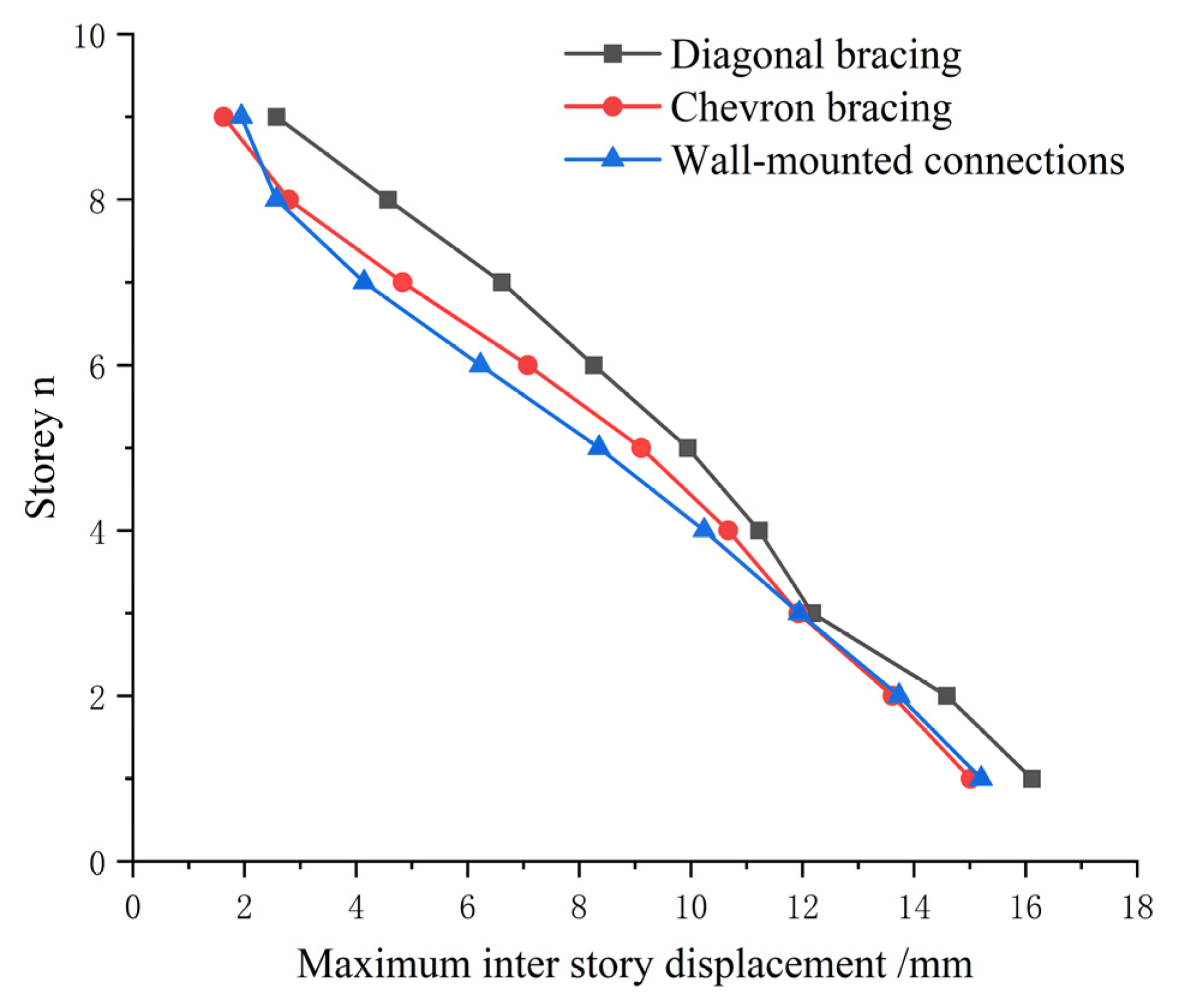
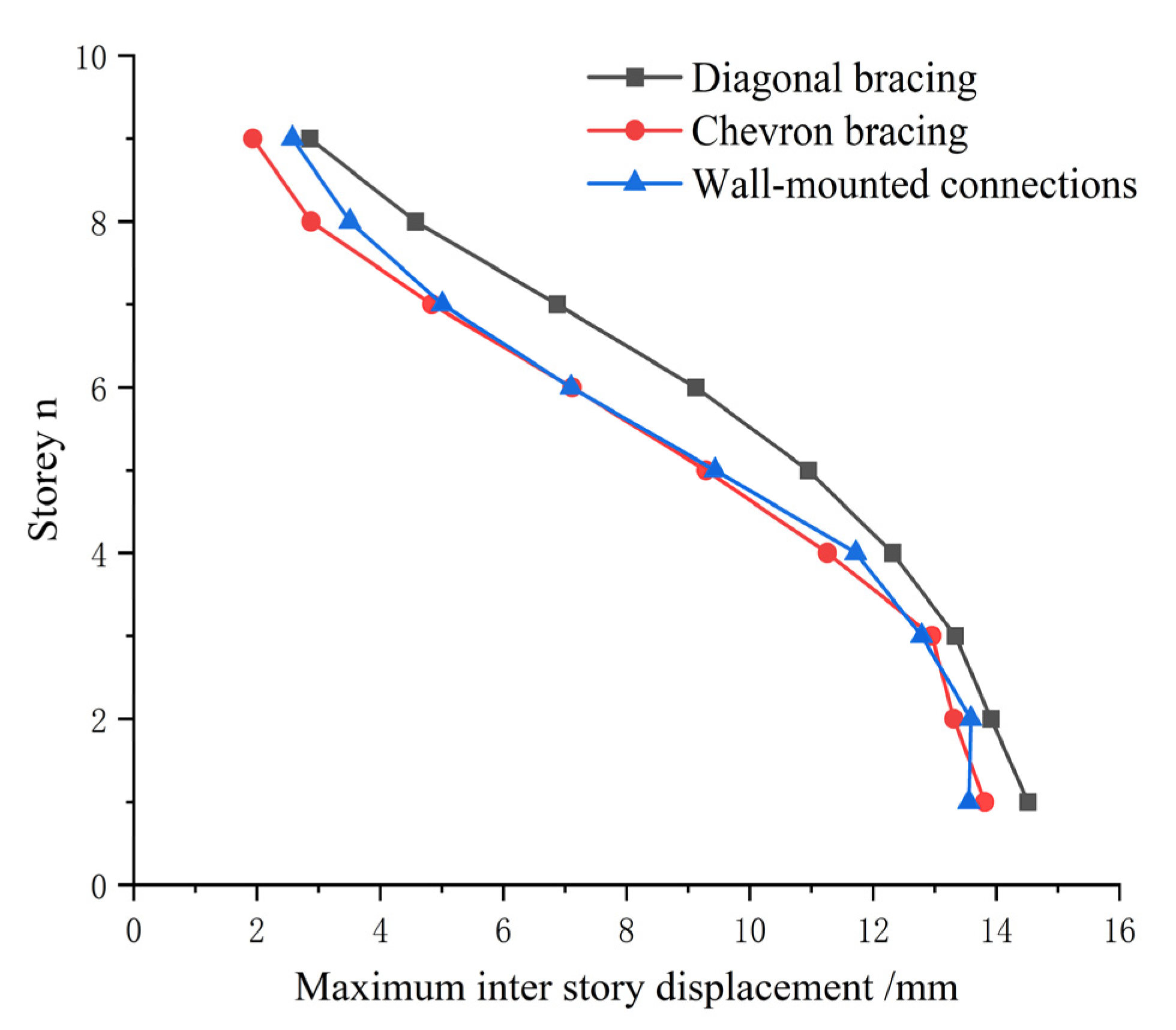
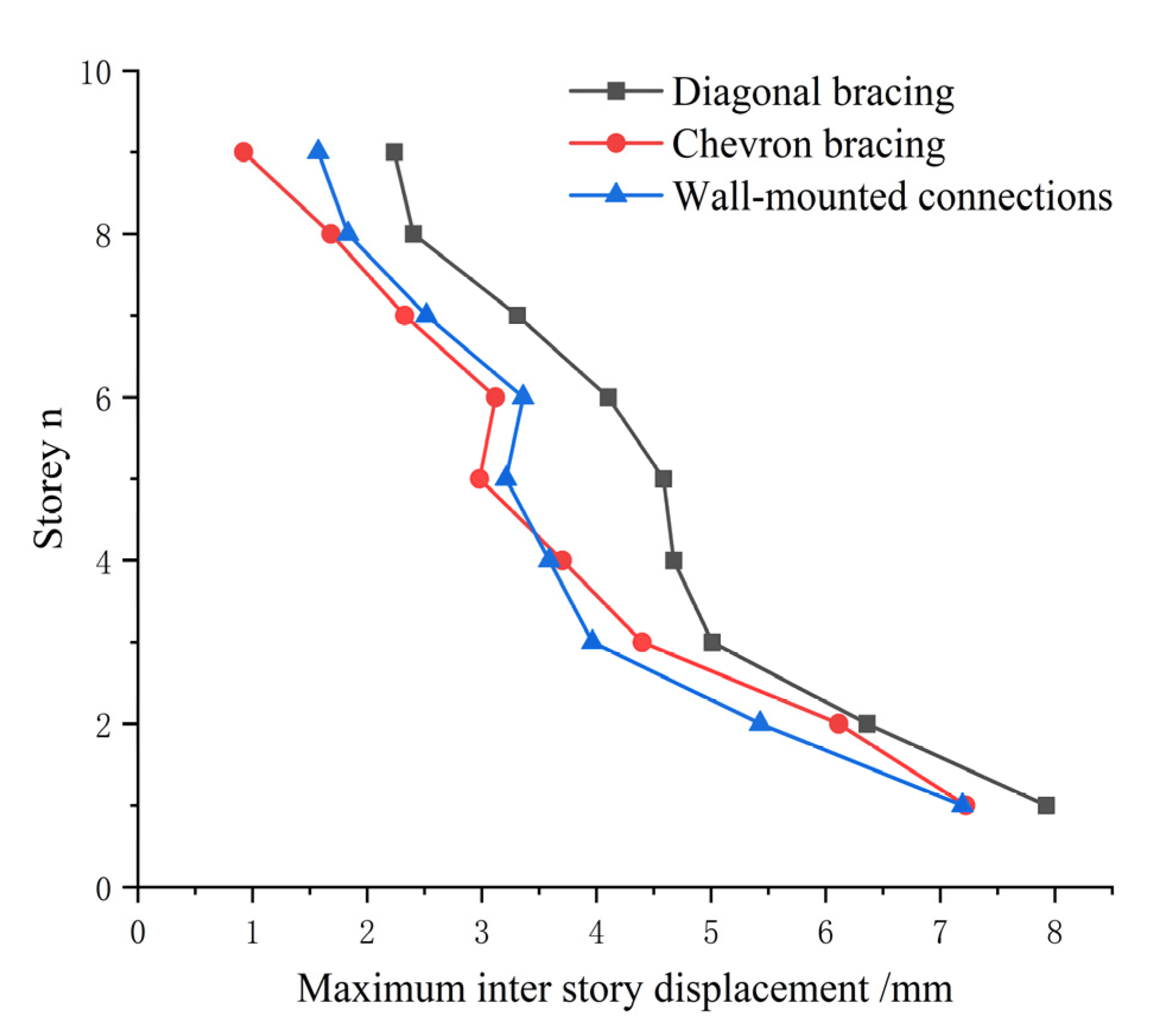
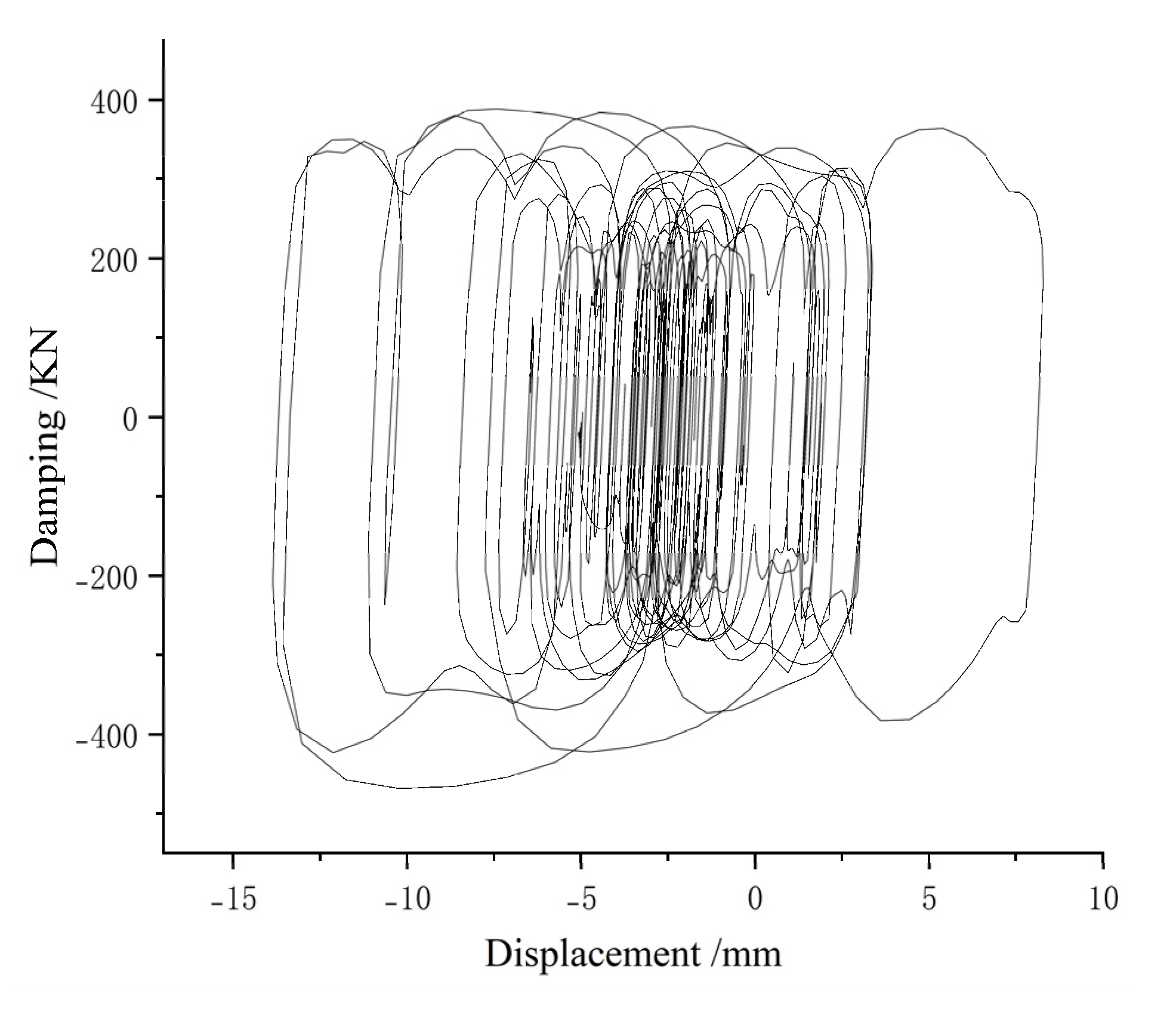

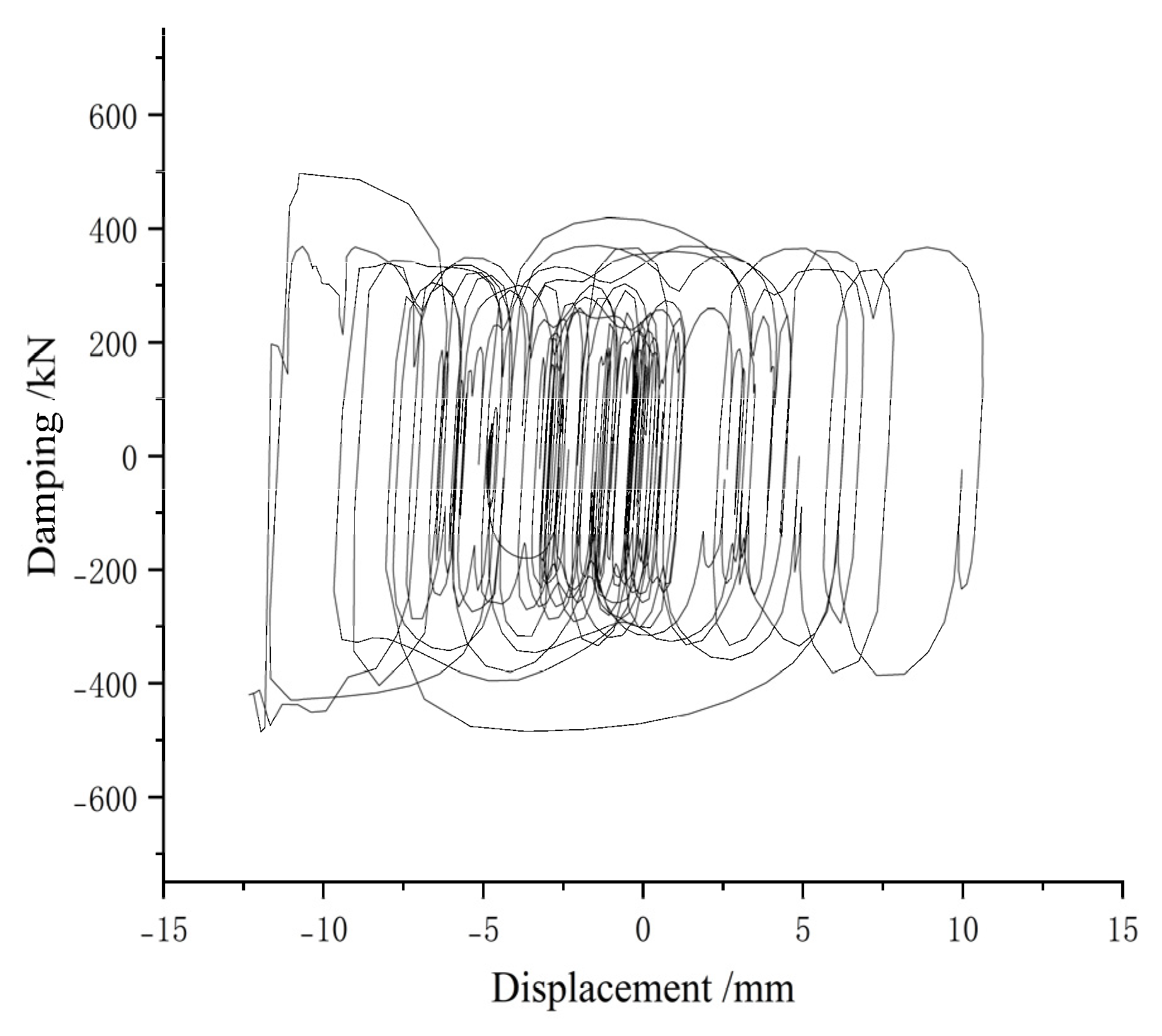

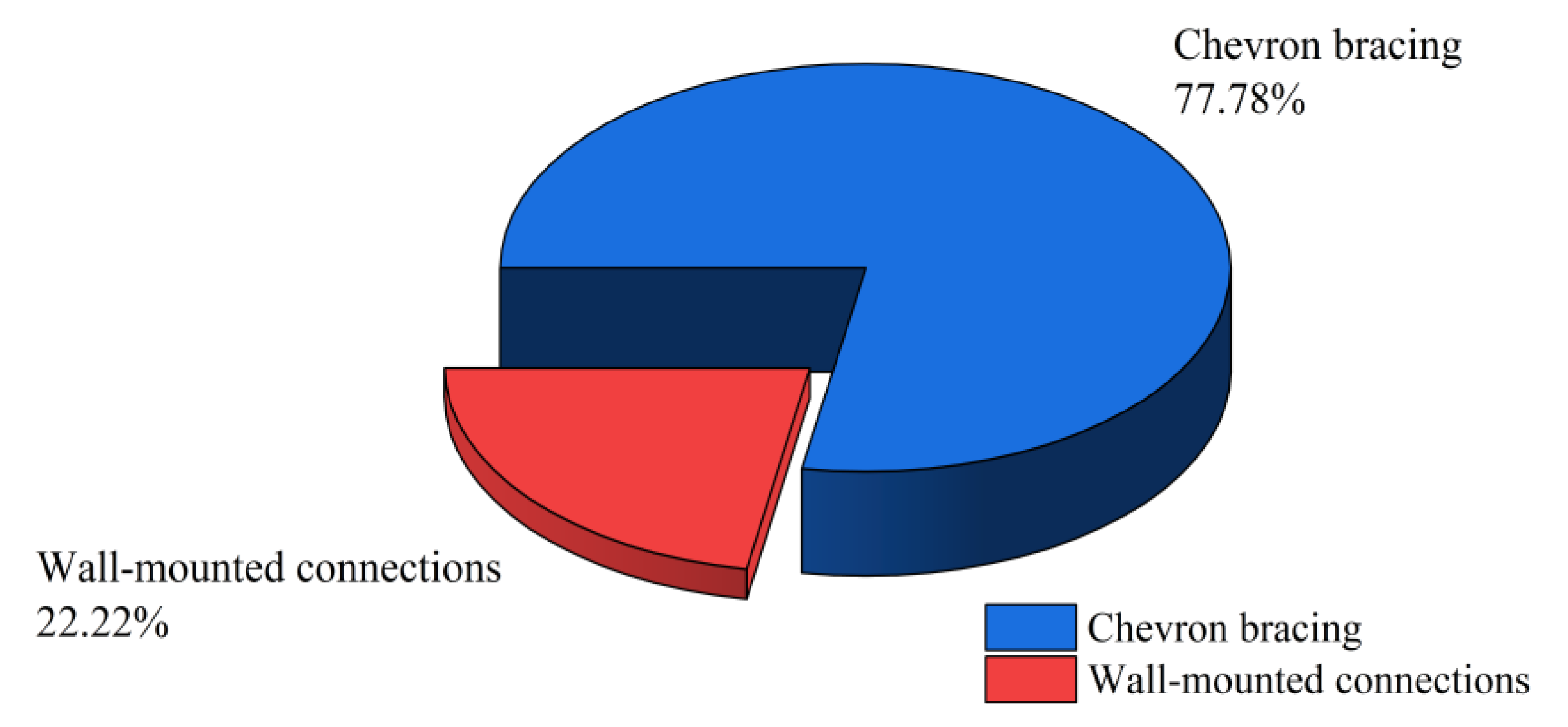
| Unit Type | Material | Dimension (mm) |
|---|---|---|
| Beam | C30 | 500 × 300 |
| Column | C40 | 500 × 500 |
| Connection Unit Type | Damping Index | Damping Coefficient (KN×(s/m)) | Number of Dampers |
|---|---|---|---|
| Damper Exponential | 0.3 | 1000 | 60 |
| Story | Diagonal Bracing (mm) | Chevron Bracing (mm) | Wall-Mounted Connections (mm) |
|---|---|---|---|
| 1–2 | 16.114 | 15.013 | 15.204 |
| 2–3 | 14.587 | 13.612 | 13.732 |
| 3–4 | 12.178 | 11.927 | 11.941 |
| 4–5 | 11.222 | 10.671 | 10.239 |
| 5–6 | 9.944 | 9.110 | 8.354 |
| 6–7 | 8.261 | 7.079 | 6.228 |
| 7–8 | 6.612 | 4.833 | 4.143 |
| 8–9 | 4.572 | 2.798 | 2.574 |
| 9–10 | 2.575 | 1.625 | 1.946 |
| Story | Diagonal Bracing (mm) | Chevron Bracing (mm) | Wall-Mounted Connections (mm) |
|---|---|---|---|
| 1–2 | 14.517 | 13.815 | 13.555 |
| 2–3 | 13.917 | 13.312 | 13.588 |
| 3–4 | 13.337 | 12.956 | 12.788 |
| 4–5 | 12.316 | 11.257 | 11.720 |
| 5–6 | 10.947 | 9.289 | 9.439 |
| 6–7 | 9.123 | 7.117 | 7.099 |
| 7–8 | 6.873 | 4.838 | 5.008 |
| 8–9 | 4.576 | 2.876 | 3.508 |
| 9–10 | 2.858 | 1.933 | 2.574 |
| Story | Diagonal Bracing (mm) | Chevron Bracing (mm) | Wall-Mounted Connections (mm) |
|---|---|---|---|
| 1–2 | 7.924 | 7.223 | 7.194 |
| 2–3 | 6.360 | 6.115 | 5.428 |
| 3–4 | 5.009 | 4.400 | 3.966 |
| 4–5 | 4.674 | 3.704 | 3.590 |
| 5–6 | 4.586 | 2.980 | 3.211 |
| 6–7 | 4.102 | 3.121 | 3.360 |
| 7–8 | 3.310 | 2.327 | 2.518 |
| 8–9 | 2.403 | 1.685 | 1.834 |
| 9–10 | 2.237 | 0.923 | 1.574 |
| Storey | Chevron Bracing | Wall-Mounted Connections |
|---|---|---|
| 1–7 | 44.44% | 55.56% |
| 8–10 | 77.78% | 22.22% |
Disclaimer/Publisher’s Note: The statements, opinions and data contained in all publications are solely those of the individual author(s) and contributor(s) and not of MDPI and/or the editor(s). MDPI and/or the editor(s) disclaim responsibility for any injury to people or property resulting from any ideas, methods, instructions or products referred to in the content. |
© 2025 by the authors. Licensee MDPI, Basel, Switzerland. This article is an open access article distributed under the terms and conditions of the Creative Commons Attribution (CC BY) license (https://creativecommons.org/licenses/by/4.0/).
Share and Cite
Zhang, X.; Zhao, S.; Jierula, A.; Liu, Q. Numerical Simulation-Based Study on Influence of Different Connection Configurations of Viscous Dampers on Seismic Performance. Buildings 2025, 15, 1827. https://doi.org/10.3390/buildings15111827
Zhang X, Zhao S, Jierula A, Liu Q. Numerical Simulation-Based Study on Influence of Different Connection Configurations of Viscous Dampers on Seismic Performance. Buildings. 2025; 15(11):1827. https://doi.org/10.3390/buildings15111827
Chicago/Turabian StyleZhang, Xiaojian, Shiyi Zhao, Alipujiang Jierula, and Qing Liu. 2025. "Numerical Simulation-Based Study on Influence of Different Connection Configurations of Viscous Dampers on Seismic Performance" Buildings 15, no. 11: 1827. https://doi.org/10.3390/buildings15111827
APA StyleZhang, X., Zhao, S., Jierula, A., & Liu, Q. (2025). Numerical Simulation-Based Study on Influence of Different Connection Configurations of Viscous Dampers on Seismic Performance. Buildings, 15(11), 1827. https://doi.org/10.3390/buildings15111827






